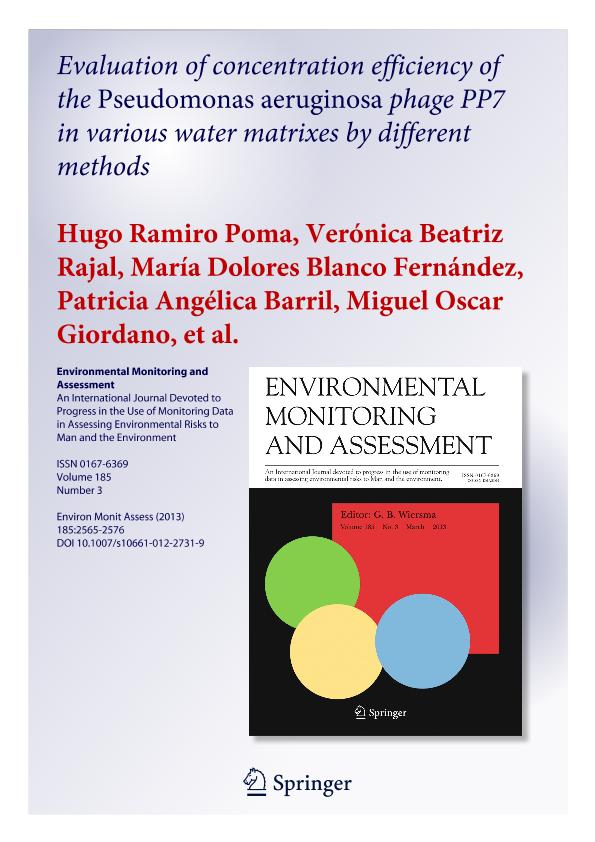Artículo
Evaluation of concentration efficiency of the Pseudomonas aeruginosa phage PP7 in various water matrixes by different methods
Poma, Hugo Ramiro ; Rajal, Verónica Beatriz
; Rajal, Verónica Beatriz ; Blanco Fernandez, Maria Dolores
; Blanco Fernandez, Maria Dolores ; Barril, Patricia Angelica
; Barril, Patricia Angelica ; Giordano, Miguel Oscar; Masachessi, Gisela
; Giordano, Miguel Oscar; Masachessi, Gisela ; Martinez, Laura Cecilia; Isa, Maria Beatriz; Freire, María Cecilia; Riviello López, Gabriela; Cisterna, Daniel Marcelo; Nates, Silvia Viviana; Mbayed, Viviana Andrea
; Martinez, Laura Cecilia; Isa, Maria Beatriz; Freire, María Cecilia; Riviello López, Gabriela; Cisterna, Daniel Marcelo; Nates, Silvia Viviana; Mbayed, Viviana Andrea
 ; Rajal, Verónica Beatriz
; Rajal, Verónica Beatriz ; Blanco Fernandez, Maria Dolores
; Blanco Fernandez, Maria Dolores ; Barril, Patricia Angelica
; Barril, Patricia Angelica ; Giordano, Miguel Oscar; Masachessi, Gisela
; Giordano, Miguel Oscar; Masachessi, Gisela ; Martinez, Laura Cecilia; Isa, Maria Beatriz; Freire, María Cecilia; Riviello López, Gabriela; Cisterna, Daniel Marcelo; Nates, Silvia Viviana; Mbayed, Viviana Andrea
; Martinez, Laura Cecilia; Isa, Maria Beatriz; Freire, María Cecilia; Riviello López, Gabriela; Cisterna, Daniel Marcelo; Nates, Silvia Viviana; Mbayed, Viviana Andrea
Fecha de publicación:
06/07/2013
Editorial:
Springer
Revista:
Environmental Monitoring and Assessment
ISSN:
0167-6369
Idioma:
Inglés
Tipo de recurso:
Artículo publicado
Clasificación temática:
Resumen
Enteric viruses monitoring in surface waters requires the concentration of viruses before detection assays. The aim of this study was to evaluate different methods in terms of recovery efficiencies of bacteriophage PP7 of Pseudomonas aeruginosa, measured by real-time PCR, using it as a viral control process in water analysis. Different nucleic acid extraction methods (silica–guanidinium thiocyanate, a commercial kit (Qiagen Viral RNA Kit) and phenol–chloroform with alcohol precipitation) exhibited very low recovery efficiencies (0.08–4.18 %), being the most efficient the commercial kit used for subsequent experiments. To evaluate the efficiency of three concentration methods, PBS (as model for clean water) and water samples from rivers were seeded to reach high (HC, 106 pfu ml−1 ) and low concentrations (LC, 104 pfu ml−1 ) of PP7. Tangential ultrafiltration proved to be more efficient (50.36±12.91, 17.21±9.22 and 12.58±2.35 % for HC in PBS and two river samples, respectively) than adsorption–elution with negatively charged membranes (1.00±1.34, 2.79±2.62 and 0.05±0.08 % for HC in PBS and two river samples, respectively) and polyethylene glycol precipitation (15.95±7.43, 4.01± 1.12 and 3.91±0.54 %, for HC in PBS and two river samples, respectively), being 3.2–50.4 times more efficient than the others for PBS and 2.7–252 times for river samples. Efficiencies also depended on the initial virus concentration and aqueous matrixes composition. In consequence, the incorporation of an internal standard like PP7 along the process is useful as a control of the water concentration procedure, the nucleic acid extraction, the presence of inhibitors and the variability of the recovery among replicas, and for the calculation of the sample limit of detection. Thus, the use of a process control, as presented here, is crucial for the accurate quantification of viral contamination.
Archivos asociados
Licencia
Identificadores
Colecciones
Articulos(CCT - CORDOBA)
Articulos de CTRO.CIENTIFICO TECNOL.CONICET - CORDOBA
Articulos de CTRO.CIENTIFICO TECNOL.CONICET - CORDOBA
Articulos(INIQUI)
Articulos de INST.DE INVEST.PARA LA INDUSTRIA QUIMICA (I)
Articulos de INST.DE INVEST.PARA LA INDUSTRIA QUIMICA (I)
Articulos(OCA HOUSSAY)
Articulos de OFICINA DE COORDINACION ADMINISTRATIVA HOUSSAY
Articulos de OFICINA DE COORDINACION ADMINISTRATIVA HOUSSAY
Articulos(SEDE CENTRAL)
Articulos de SEDE CENTRAL
Articulos de SEDE CENTRAL
Citación
Poma, Hugo Ramiro; Rajal, Verónica Beatriz; Blanco Fernandez, Maria Dolores; Barril, Patricia Angelica; Giordano, Miguel Oscar; et al.; Evaluation of concentration efficiency of the Pseudomonas aeruginosa phage PP7 in various water matrixes by different methods; Springer; Environmental Monitoring and Assessment; 185; 3; 6-7-2013; 2565-2576
Compartir
Altmétricas



